

Java Video Tutorial 15. Learn Java Tutorial 1.10- Implements an Interface (implementing in java) The technology and education center. Java.lang.Object Class. Java Arrays. Java Arrays has average rating 8 out of 10.
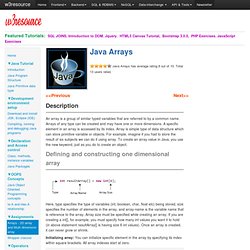
Total 13 users rated. <<PreviousNext>> Description An array is a group of similar typed variables that are referred to by a common name. Arrays of any type can be created and may have one or more dimensions. Defining and constructing one dimensional array Here, type specifies the type of variables (int, boolean, char, float etc) being stored, size specifies the number of elements in the array, and array-name is the variable name that is reference to the array. Initializing array: You can initialize specific element in the array by specifying its index within square brackets. ResultArray[0]=69; This will initialize first element (index zero) of resultArray[] with integer value 69. Array Literals The null literal used to represent the absence of an object can also be used to represent the absence of an array. String [] name = null; String[] daysOfWeek = {“Sunday”, “Monday”, “Tuesday”, “Wednesday”, “Thursday”, “Friday”, “Saturday”}; Output.
Array Operations in Java. Core Java Programming Tutorial for C and C++ Programmers free and online ! PICKaTUTORIAL.COM. Like C and C++, array is a very useful structure in Java programming language too.
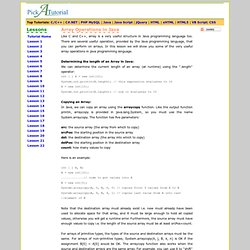
There are several useful operation, provided by the Java programming language, that you can perform on arrays. In this lesson we will show you some of the very useful array operations in java programming language. Determining the length of an Array in Java: We can determine the current length of an array (at runtime) using the ".length" operator: int [ ] A = new int[10]; System.out.println(A.length); // this expression evaluates to 10 A = new int[15]; System.out.println(A.length); // now it evaluates to 15 Copying an Array: In Java, we can copy an array using the arraycopy function. Like the output function println, arraycopy is provided in java.lang.System, so you must use the name System.arraycopy. The function has five parameters: Here is an example: For arrays of primitive types, the types of the source and destination arrays must be the same.
How to use Java Arrays. How to use Java Arrays An array is a very common type of data structure where in all elements must be of the same data type.Once defined , the size of an array is fixed and cannot increase to accommodate more elements.The first element of an array starts with zero.
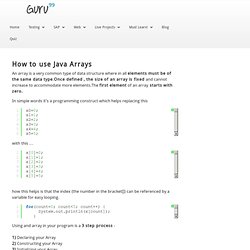
In simple words it’s a programming construct which helps replacing this with this … how this helps is that the index (the number in the bracket[]) can be referenced by a variable for easy looping. Java Tutorial – 07 – Arrays - Programming Video Tutorials. An array is a data structure used for storing a collection of values.

Array declaration To declare an array, a set of square brackets is appended to the data type the array will contain, followed by the array’s name. Alternatively, the brackets may be placed after the array name. Java Video Tutorials - Online Java Programming Tutorial Videos. Java Fundamentals Tutorial : Data Types. Primitive Data Types in Java 3.1.
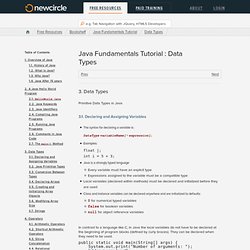
Declaring and Assigning Variables The syntax for declaring a variable is: DataType variableName[ = expression]; Examples: float j; int i = 5 + 3; Java is a strongly typed language Every variable must have an explicit type Expressions assigned to the variable must be a compatible type Local variables (declared within methods) must be declared and initialized before they are used Class and instance variables can be declared anywhere and are initialized to defaults: 0 for numerical typed variables false for boolean variables null for object reference variables In contrast to a language like C, in Java the local variables do not have to be declared at the beginning of program blocks (defined by curly braces).
They can be declared when they need to be used. Multiple variables can be declared on a singe line: int i, j, k; Multiple variables can be initialized at the same time: i = j = k = 5; Java Static. Java Beginners TutorialJava array tutorials with examples. Java Classes. As you saw in the text about the Java main program, the execution of a Java program starts in the main() method of a class.
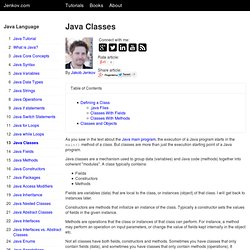
But classes are more than just the execution starting point of a Java program. Java classes are a mechanism used to group data (variables) and Java code (methods) together into coherent "modules". A class typically contains: Fields Constructors Methods Fields are variables (data) that are local to the class, or instances (object) of that class. Constructors are methods that initialize an instance of the class. Methods are operations that the class or instances of that class can perform. Not all classes have both fields, constructors and methods. Java Tutorial. Java For Beginners - Contents Page. Arrays (Class)Processing. Java provides a data structure, the array, which stores a fixed-size sequential collection of elements of the same type.

An array is used to store a collection of data, but it is often more useful to think of an array as a collection of variables of the same type. Instead of declaring individual variables, such as number0, number1, ..., and number99, you declare one array variable such as numbers and use numbers[0], numbers[1], and ..., numbers[99] to represent individual variables. This tutorial introduces how to declare array variables, create arrays, and process arrays using indexed variables.